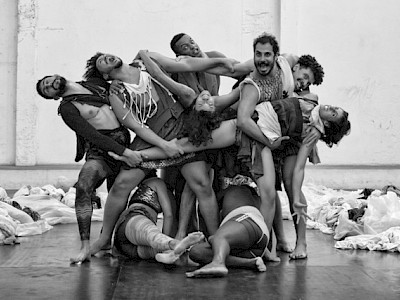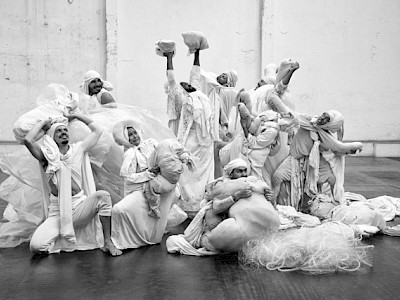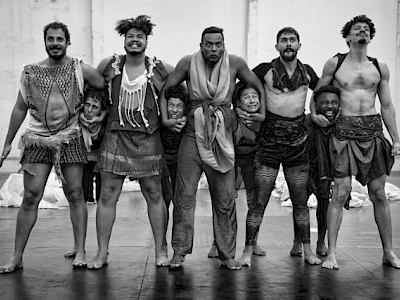28 — 31.05.2025
'Borda' in Portuguese refers to embroidery, decoration, but also to a border, the periphery, something that separates. Geographical and political borders create contradictions: hospitality and hostility, native and non-native. Who belongs and who is excluded, who has a right to exist? Metaphorically, the word 'borda' also means imagination, the ability to cross borders, to transcend.
With a new generation of dancers, choreographer Lia Rodrigues weaves a porous embroidery of liquid otherness, with edges that fray, float and dance. In her signature style, starting from the energy of the collective and using simple materials like textiles and plastic, she creates a unique ballet between bodies and matter whose recipe only Rodrigues seems to know. Bodies clump together into constellations, form masses and separate again. With great care, what was separated is brought back together. The result is a succession of powerful images and colourful tableaux.
Rodrigues, after the savoured large-venue productions Fúria and Encantado (Kunstenfestivaldesarts 2019 and 2022), once again blankets us in comfort and hope. For the first time, she premieres a new creation in Brussels to close off the 30th edition of the festival.
Interview with Lia Rodrigues
Beatrice Lapadat – In developing Borda, how would you describe the process?
Lia Rodrigues – The development of Borda began when I gathered together on set almost all the costumes we had used over the course of our 35 years of performances, even the costumes from May B—a show that Maguy Marin presented to us in 2017, following a project between our dance school in Maré and Lyon—right down to the plastics used in Pindorama. I brought all these objects and costumes back to life and said to myself: “We’re going to create a world with all this!” Using all these elements that had remained with us after the completion of our creations, some of which had been lying around in my suitcases for years, we began to embroider and create characters that form a kind of organism where each one depends on the other. This is about the relationship we have with all these objects and costumes, but also about the way the dancers construct their interactions. It should also be noted that Borda is a continuation of Fúria (2018) and Encantado (2021), thus constituting the final part of this triptych. For me, it’s as if two planets had collapsed and given birth to Borda, although many of the company’s other creations are present in this show in a less explicit way.
The Portuguese word ‘borda’ has multiple meanings, ranging from the idea of a physical border to that of dreams and fantasies. How do you plan to make this whole network of meanings visible in Borda?
We tend to think of borders in geographical and political terms, but I think it’s essential to open our minds to other possibilities. Crossing a border is first and foremost an internal process, a border that we cross within ourselves—this is how we achieve transformation, transition, everything that drives us to move from one place to another, from one state to another, from one perspective to another. Imaginary borders take us to these porous places populated by nomadic flows, dreams, and fluid otherness. Among the different meanings of ‘borda’, I am particularly interested in the one that refers to edges, those areas of biodiversity that are so rich and resilient. In the living world, edges are places where everything fertilises everything else, where the land meets the sea, the forest meets the field, the river meets its banks. It is a space where cultures and disciplines intersect to cultivate creative friction rather than conflict. It is here that we can hope to reinvent ourselves, transform ourselves, and build transitions. Because Borda is also an invitation to cross the boundaries between ourselves in order to create a dream space where everyone can imbue the show with the meaning of the stories they wish to create. Imagination and dreams remain essential fuels for moving forward and activating new ways of being in the world.
What are the main dramatic and aesthetic features that characterise Borda?
In Borda, we sought to explore another physical world with the help of the nine performers—six male dancers and three female dancers—who also participate in the dramaturgy of the show through the discussions we initiate around our work. I don’t know if we succeed in achieving this, but we always try not to stay in the same place, to evolve—which doesn’t necessarily mean ‘moving forward’ but simply heading towards another place, even when it’s unknown to us. In this creation, cooperation is at the heart of the choreographic challenges: it is only together that the dancers can carry out this highly precise work, where each one depends on the other to create and exist. At the same time, embroidery—another meaning of the term ‘borda’—is highlighted through the idea of craftsmanship. We are our own couturiers, we make, recycle and tinker with our costumes—which requires a lot of time and attention to detail—in order to create a world that defines us. This is where I see a link between embroidery and choreography: we take things that are ‘nothing’ and transform them by the very act of staging them.
What did you gain from creating Andantes? Did this participatory experience change or influence your way of working?
The festival’s invitation to participate in the Zinneke Parade offered me a unique opportunity. Andantes had confirmed the value of group work, which I’ve been doing since I started out as a choreographer, with people from very different backgrounds and walks of life. Creating this float for the parade, this living car, allowed me to see in a new way how artistic work can intertwine with these very different realities, with each participant bringing to the work their own unique way of being and existing in the world.
When the time came to be together in the streets, it was emotional to see everyone happy and having fun together. I think it’s very important right now, given the global situation, to create spaces for sharing, for joy and pleasure. Andantes has confirmed once again that it’s possible to build something with people who are very different from one another and to create a sense of ‘living together’.
- Interview by Beatrice Lapadat in March 2025 for the Festival d’Automne à Paris.
- Translated by Jodie Hruby.
- Beatrice Lapadat is a researcher in stage arts, a cultural journalist, critic and educator.
Presentation: Kunstenfestivaldesarts, Théâtre National Wallonie-Bruxelles
Created by: Lia Rodrigues | Danced and created in collaboration with: Leonardo Nunes, Valentina Fittipaldi, Andrey da Silva, David Abreu, Raquel Alexandre, Daline Ribeiro, João Alves, Cayo Almeida, Vitor de Abreu | Assistant creation: Amalia Lima | Dramaturgy: Silvia Soter | Artistic collaboration and images: Sammi Landweer | Lighting design: Nicolas Boudier | Lighting and stage management: Magali Foubert, Baptistine Méral | Soundtrack: Miguel Bevilacqua (based on excerpts from a recording made in 1938 in northern Brazil by writer and intellectual Mario de Andrade's Missão de Pesquisas Folclóricas / Musical excerpt ‘Amor Amor Amor’ (public domain) which is part of the repertoire of the ‘Cavalo Marinho’, a dramatic Brazilian dance performed by Luiz Paixão) | International booking: Colette de Turville | Production coordinator: Astrid Toledo | Production and booking Brazil: Gabi Gonçalves / Corpo Rastreado | Secretary and administration: Gloria Laureano | Teachers: Amalia Lima, Leonardo Nunes, Valentina Fittipaldi, Andrey Silva | Costumes: Lia Rodrigues Companhia de Danças | Tailor: Antonia Jardilino de Paiva | Acknowledgements: Thérèse Barbanel, Corpo Rastreado, Inês Assumpção, Luiz Assumpção, Diana Nassif, l’équipe du Centro de Artes da Maré, Jacques Segueilla
Production: Lia Rodrigues Companhia de Danças | Coproduction: Kunstenfestivaldesarts, Maison de la danse/Biennale de la danse de Lyon 2025, Chaillot Théâtre National de la Danse, CENTQUATRE-PARIS, Festival d’Automne à Paris, Wiener Festwochen, La Bâtie - Festival de Genève, Romaeuropa Festival, PACT Zollverein, One Dance Festival, Theater Freiburg, Muffatwerk, Passages Transfestival, Festival PERSPECTIVES, Le Parvis, Tanz im August / HAU Hebbel am Ufer
With the support of the Ammodo Foundation, Redes da Maré and Centro de Artes da Maré
Lia Rodrigues is International Associate Artist at CENTQUATRE-PARIS, Maison de la danse de Lyon, Pôle européen de création and Biennale de la danse de Lyon
Dedicated to Max Nassif Earp




